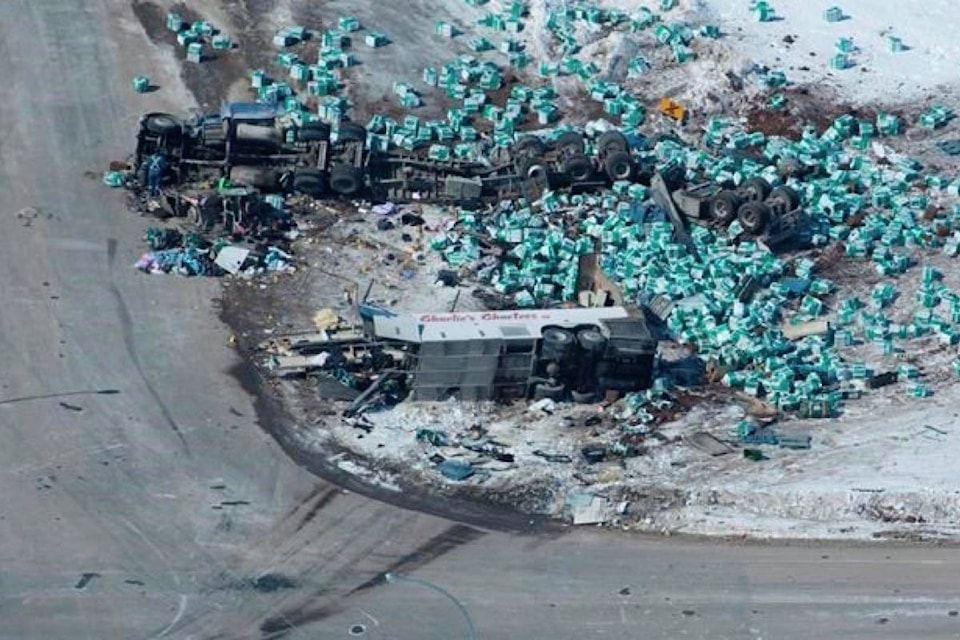The investigation into a deadly crash that killed 15 people in northeastern Saskatchewan last Friday will be a long and painstaking one, according to several collision experts.
Retired RCMP collision analyst Rob Creasser says months of work could lie ahead for the analysts and reconstruction experts who are tasked with piecing together the circumstances that caused the collision between a semi truck and a bus carrying the Humboldt Broncos hockey team.
Weather, skid marks, visibility, speed and the mechanical condition of the vehicles are just a few of the factors that will eventually be analyzed in order to reconstruct the crash, according to Creasser, a 28-year veteran with the RCMP in British Columbia.
“It’s almost physics,” he said in a phone interview. “Two objects come together and they depart at different angles, and you’re looking for any indication of braking, skid marks, gouge marks on the roadway, that kind of thing.”
READ MORE: Hockey sticks on porches across the country in tribute to Humboldt crash victims
READ MORE: B.C. hockey chaplain helps community grieve after Humboldt Broncos’ bus crash
Creasser said the initial gathering of information at the scene takes hours or days, as investigators try to find clues and work to create a comprehensive map that includes the location of each piece of debris and the vehicles’ resting places.
But analyzing that data can take much longer.
Computer simulations, he said, will eventually recreate the moments leading to the crash, while a parallel investigation will tackle witness and survivor statements.
There are also vehicle maintenance reports to obtain, and mechanics to be brought in to examine the engines of the shattered vehicles for any defects.
“When there’s a human death, there’s an autopsy,” he said. ”Well, this is the autopsy of the vehicles.”
In Friday’s tragedy, the truck was heading west at the intersection south of Nipawin when it collided with the bus. The force of the crash propelled both vehicles into the ditch at the northwest corner of the intersection.
Aerial footage showed the bus on its side, its roof peeled back and its front end destroyed.
The trailer of the truck lay nearby in a shattered mess, with bags of its peat moss cargo scattered all around. The tractor part was intact, lying on its passenger side.
The semi truck would have had to yield to a stop sign before crossing over the highway the hockey bus was travelling on. There is a stand of trees on the southeast corner of the intersection, limiting visibility of the approach on both roads.
In the case of the Humboldt accident, ”the scene talks a lot,” according to former Quebec provincial police crash expert Pierre Bellemare.
Bellemare, who retired in 2005 after 25 years of service, says that since the road travelled by the bus didn’t have a stop sign, investigators will have to determine whether the semi truck came to a full stop at the intersection.
That, he said, will involve speaking to survivors and witnesses, confirming the truck’s speed, load, and mechanical condition, and checking for anything that may have impeded the driver’s field of vision.
Investigators will also look at the safety of the intersection where the crash occurred.
Jason Young, the president of Toronto-based reconstruction company Advantage Forensics, says analysts will look at the intersection’s history of recent accidents and make sure the road meets Canadian design standards for safety and visibility.
“We’re looking at the visibility across the corners, the visibility the driver on the side road has of approaching vehicles in both directions,” said Young, who has not viewed the site and is not involved in the investigation.
If traffic conditions and the accident history warrant, municipalities could eventually change an intersection to a four-way stop or a traffic signal, he said.
Some experts, he said, are also recommending increasing the number of roundabouts at intersections as a way to avoid often deadly T-bone collisions.
All three experts agree that a major investigation such as the Humboldt one is likely to take time, involving input from police, reconstruction experts, government agencies, mechanics, engineers, and eventually the Crown.
“This is something you don’t want to rush,” Creasser said. “You want to do a very thorough investigation, and you’re not counting on only you.”
He’s hoping the public will spare a thought for the front-line workers, many of whom are likely struggling with the trauma they’ve witnessed.
“You can’t unsee something,” he said. “You can imagine what those members who are first on scene, and those who came subsequently, saw.”
Morgan Lowrie, The Canadian Press
